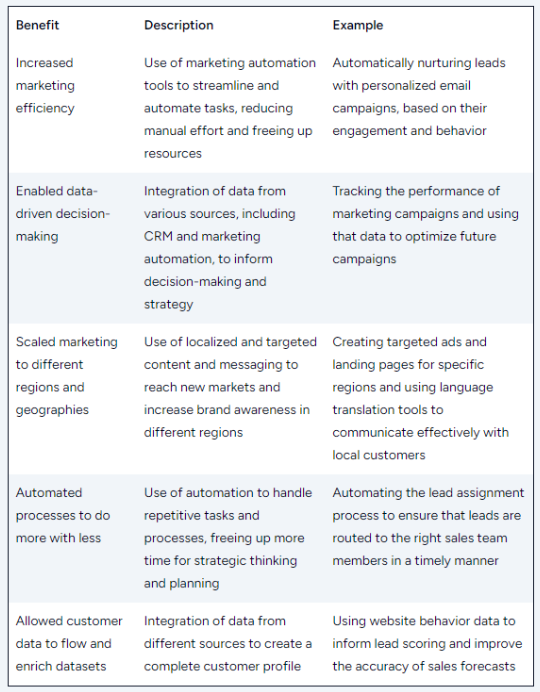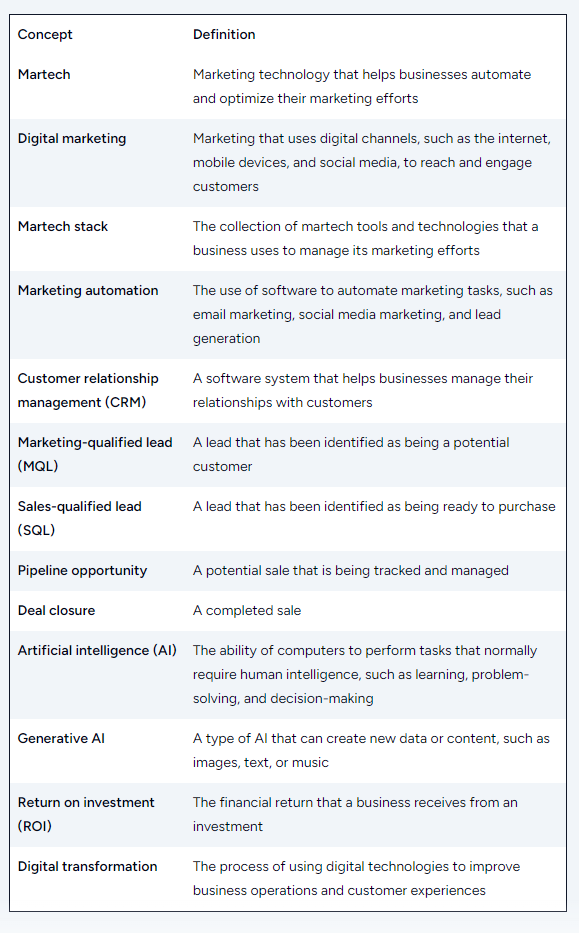
Digital marketing can only run on the foundation of martech.
Without a solid martech stack, it’s impossible to do marketing. At the same time, having a solid martech stack doesn’t guarantee marketing success, either. But there are certainly many benefits of martech for a company’s competitive advantage.
Many elements, including technologies, copy, design, messaging, and customer experience all need to work well together. That’s why modern marketing is so hard.
Even though you can’t reap the immediate benefits of a solid martech stack, having one in place gives significant competitive advantages for enterprises over time.
Key benefits of a great back-end martech integration:
- Increase marketing efficiency
- Enable data-driven decision-making
- Scale marketing to different regions and geographies
- Automate processes to do more with less
- Allow customer data to flow and enrich your datasets
Incorporate CRM as part of martech stack
Marketers, including myself, focus on technological tools related to campaigns and outbound communications. However, if you would like to track your demand gen efforts, you need to take your tech stack down to the middle and bottom of the purchase funnel. That is the sales side.
Scoring high-quality marketing-qualified leads (MQL) is the ultimate win for marketing. However, you only know if your MQLs are high-quality when pipeline opportunities are created.
Therefore, it’s a MUST to incorporate CRM as part of your overall martech stack.
Plus, I’d strongly encourage marketers to know how your company’s CRM actually works. The more you know, the more you can articulate the revenue impact and contribution of marketing.
Tip: KNOW YOUR CRM!
Tie CRM and marketing automation into your website
The website no longer is a stand-alone online presence. Email subscriptions, contact forms, webinar registrations, etc. all need to flow into marketing automation tools, or even contact information into CRM, depending on your lead and prospect vetting processes.
I understand many websites can see the email subscription names and contact names in the back-end, but they all need to flow into marketing automation so that all marketing customer data is tracked in one place, not scattered across many locations.
We all have a hard time tracking our customers because they reside in so many different places. You need to consolidate or use an API to connect and flow the data.
Another thing about your website is that you need to constantly update and refresh it with new product releases, new content, even going so far as to test out different value propositions and copy. You can no longer afford to have a stale website. Be sure to constantly update, refresh, and optimize it. I do this all the time. It’s a pain, but it pays off.
Tip: Customer data you gather from your website needs to flow into marketing automation tools and CRM.
Define customer journey via marketing channels
It took me a long time to fully understand what “customer journey” really means. Yes, on the surface, it means a journey that your customer takes to find you, and then, eventually (hopefully, anyway) engage with you and buy your product.
In that case, there are many paths that a customer can take to find you or engage with you. Can you manage all these path options? Probably not; that would be crazy.
Customer journeys should be defined as how YOU want to “guide” your prospects based on your intended channels.
For example, you might run a LinkedIn ad to promote your webinar, and the ad leads to your registration page.
After the webinar, you send a thank-you email based on the prospect’s attendance (or lack thereof). Then, you follow up with several drip emails that you think can pique their interest to talk to sales and get to know more about your products.
Your customer experience should focus on that following and make things as seamless as possible, plus the content you offer along the way should be as personalized or useful as possible.
All roads (customer journeys) lead to Rome (your CRM), especially MQLs → SQLs → pipeline opportunities → deal closures.
Tip: Focus on the journeys that you can control.
Artificial intelligence in marketing makes martech even more complicated
The popular topic for martech nowadays is precise marketing with artificial intelligence (AI). You literally can’t talk about tech without mentioning AI.
For enterprise and B2B marketing, the incorporation of AI for marketing automation will be gradual and slow, largely because of legal and regulatory compliance.
Whatever you decide to do, please make sure that you consult your legal team. If you use generative AI to create images, it may not consider your IP. Will that put your company at risk or liability?
If you use an AI writing assistant to generate content, can that be counted as original content? Again, will you put your company at risk? These are all things to consider as you weigh in on the importance of martech and AI for modern business.
Another layer of complexity is the martech stack modifications. Say, for example, that you have a pretty solid workflow and tech stack, how will AI disrupt the flow? What part of the flow can be automated?
Working on incorporating AI for marketing automation into enterprises or B2B will take a long time. It’s a journey of its own, yet new AI tools are popping up everywhere. That’s also another reason why marketers are feeling overwhelmed when it comes to martech and AI adoption; on one hand, their hands are tied to move fast due to legal compliance concerns, but on the other, management is asking for more automation and usage of AI.
We are all walking on the tightrope of what to implement and what to use. If you feel the struggle, you are not alone.
Every company will walk its own pace when it comes to AI adoption. AI is essential for modern marketing, but it will take us a little while to build the right workflows.
Measure ROI through martech
Digital transformation is another fancy term for martech stack integration. It’s very hard to measure the heavy investment in marketing and sales tech because it’s all about up-front investment, annual usage and subscription fees.
I always tell my clients that a martech budget should not be part of a demand gen or marketing outreach budget. It should be a separate bucket of its own. Technology is expensive. I invest heavily in technologies to keep myself up-to-speed.
One way that you can measure the ROI is by considering whether or not the martech expenses increase the number of leads, enable revenue growth, allow more campaigns to run, or automate manual processes.
As a marketing ops team managing a martech stack, you can also gather feedback from both sales and marketing. Their testimonials should serve as one aspect of the holistic ROI measurement for martech solutions.
Continue to refine your martech stack
Your company’s competitive advantage is also built on technologies, yet, somehow, a company’s martech tends to be complicated.
I always encourage marketers to understand the company’s martech stack. The more you understand, the better off you are at connecting different dots. The more dots you can connect, the more strategic you are. The more strategic you are, the more you can help your management understand the value of technologies.
Helping them understand martech stack (not in a tedious way) will allow them to understand the complexity of modern marketing. The more they understand the complexity of modern marketing and martech strategies, the more emphatic they’ll be about how difficult marketing can be in this brave new world.
Educate others about where you stand with martech solutions. Help them to help you.
If you’re looking to gain a better understanding of MarTech and leverage it to your advantage, don’t hesitate to reach out to me .
I am here to help!
BTW, here is a table that provides definitions for all the B2B marketing terms mentioned in the blog post.





